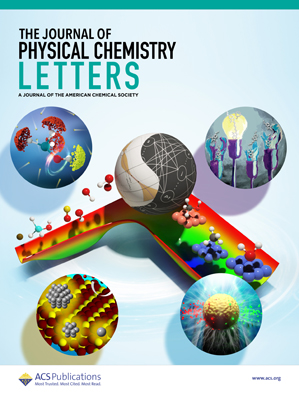激子和双激子跃迁揭示了mn掺杂CsPbCl3纳米晶体中的俄歇和能量传递动力学
IF 4.6
2区 化学
Q2 CHEMISTRY, PHYSICAL
引用次数: 0
摘要
飞秒瞬态吸收(TA)光谱是一种强大的技术,已被用于解开卤化物钙钛矿纳米晶体(NCs)中的超快激子动力学。激子的状态填充效应引起的漂白被广泛地用于提取钙钛矿纳米碳管中的激子动力学,而诱导吸收信号在很大程度上被忽视。我们发现,在未掺杂和mn掺杂的CsPbCl3 nc中,高能级激子的光泵浦导致激子漂白和红移和蓝移诱导吸收共振,这是由激子到双激子的跃迁引起的。虽然激子漂白和双激子诱导吸收信号都提供了激子到mn的能量转移(ET)时间尺度,但我们的分析表明,双激子诱导吸收共振可能提供更准确的ET时间尺度,并显示出强烈的mn含量依赖性。重要的是,漂白动力学提供了双激子俄格重组(和载流子捕获)速率的信息,随着mn含量从~ 37到~ 20 ps(和~ 13到~ 6 ps)的增加,该速率变得更快,这是ET效率提高的直接结果。因此,本文提出的细致分析提供了TA光谱中经常被忽视的诱导吸收信号的重要性,可以用来获得更深入的基础知识。本文章由计算机程序翻译,如有差异,请以英文原文为准。

Exciton and Biexciton Transition Reveals Auger and Energy Transfer Dynamics in Mn-Doped CsPbCl3 Nanocrystals
Femtosecond transient absorption (TA) spectroscopy is a powerful technique that has been used to disentangle ultrafast exciton dynamics in halide perovskite nanocrystals (NCs). The bleaching caused by the state-filling effect of the excitons is extensively and almost exclusively used to extract the exciton dynamics in perovskite NCs, whereas the induced absorption signals remain largely overlooked. We show that optical pumping of the higher-lying excitons results in exciton bleaching and red- and blue-shifted induced absorption resonances, caused by the exciton-to-biexciton transitions, in both undoped and Mn-doped CsPbCl3 NCs. While both exciton bleaching and biexciton induced absorption signals deliver the exciton-to-Mn energy transfer (ET) time scale, our analysis suggests that the biexciton induced absorption resonance may provide a more accurate ET time scale and shows a strong Mn-content dependence. Importantly, the bleaching dynamics provide information on the biexciton Auger recombination (and carrier trapping) rates, which become faster with increasing Mn-content from ∼37 to ∼20 ps (and ∼13 to ∼6 ps), a direct consequence of the enhancement of the ET efficiency. The meticulous analysis presented herein thus delivers the importance of the induced absorption signals in TA spectra that often remain ignored and can be used to gain deeper fundamental knowledge.
求助全文
通过发布文献求助,成功后即可免费获取论文全文。
去求助
来源期刊

The Journal of Physical Chemistry Letters
CHEMISTRY, PHYSICAL-NANOSCIENCE & NANOTECHNOLOGY
CiteScore
9.60
自引率
7.00%
发文量
1519
审稿时长
1.6 months
期刊介绍:
The Journal of Physical Chemistry (JPC) Letters is devoted to reporting new and original experimental and theoretical basic research of interest to physical chemists, biophysical chemists, chemical physicists, physicists, material scientists, and engineers. An important criterion for acceptance is that the paper reports a significant scientific advance and/or physical insight such that rapid publication is essential. Two issues of JPC Letters are published each month.
 求助内容:
求助内容: 应助结果提醒方式:
应助结果提醒方式:


